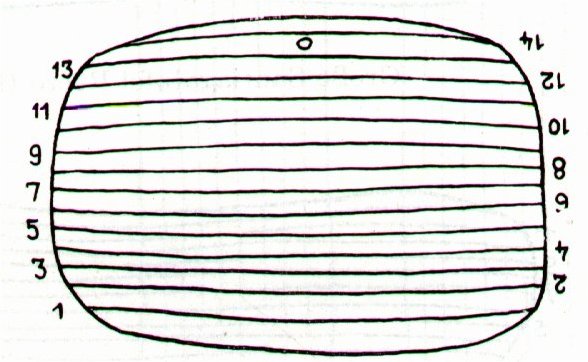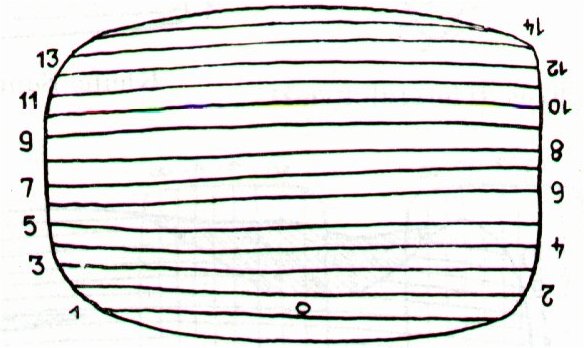From
the
central
Venus
star
Spica
below
the
equator
and
up
to
the
Fox
star
Alcor
(80
Ursae
Majoris)
we can
imagine
a
straight
vertical
'zero'
time
line,
which
might
have
motivated
the
reversed
hau
tea
at
the
beginning
of
line
Gb4:

 |
| Gb4-4 (324) |
|
February 8 (404) |
|
Achernar
(23.3), χ Andromedae (23.6), τ Andromedae (23.9) |
|
August 10 (222) |
|
Heze (205.0) |
 |
 |
 |
 |
 |
 |
 |
|
Gb4-5 (325) |
Gb4-6 |
Gb4-7 |
Gb4-8 (99) |
Gb4-9 |
Gb4-10 |
Gb4-11 |
|
February 9 (40) |
10 |
11 |
12 (408) |
13 |
14 |
15 |
|
no star listed (24) |
no star listed (25) |
ANA-NIA |
Al Sharatain-1 /
Ashvini-1
/
Bond-16 |
ι Arietis (28.0), λ
Arietis (28.2) |
Alrisha, χ Phoenicis
(29.2), Alamak (29.7) |
2h (30.4) |
|
POLARIS,
Baten Kaitos (26.6), Metallah (26.9) |
Segin,
Mesarthim,
ψ Phoenicis (27.2),
SHERATAN,
φ Phoenicis (27.4) |
κ Arietis (30.3), Hamal
(30.5)
Alkes
|
| August 11 |
12 |
13 |
14 |
15 |
16 |
17 (229) |
| ε
Centauri (206.3) |
no
star listed (207) |
τ
Bootis (208.2), Benetnash (208.5), ν Centauri (208.7), μ Centauri, υ
Bootis (208.8) |
no
star listed (209) |
Muphrid (210.1), ζ Centauri (210.3) |
φ
Centauri (211.0), υ¹ Centauri (211.1), υ² Centauri (211.8), τ
Virginis (211.9) |
Agena
(212.1), θ Apodis (212.5), Thuban (212.8) |
 |
 |
 |
 |
 |
 |
|
Gb4-12 |
Gb4-13 |
Gb4-14 |
Gb4-15 |
Gb4-16 (336) |
Gb4-17 (108) |
|
February 16 |
17 (413) |
18 |
19 (50) |
20 |
21 |
|
η Arietis (31.9) |
no star listed (32) |
θ Arietis (33.3), Mira
(33.7) |
no star listed (34) |
ξ Arietis (35.0) |
no star listed (36) |
| August
18 |
19 |
20 |
21 |
22 |
23 (235) |
|
14h (213.1) |
Neck-2 |
Al Ghafr-13 /
Svāti-15
TAHUA-TAATA-METUA-TE-TUPU-MAVAE |
ι Lupi, 18 Bootis (216.3), Khambalia
(216.4), υ Virginis (216.5), ψ Centauri (216.6), ε Apodis (216.8) |
Asellus Primus (217.8) |
τ Lupi (218.1), φ Virginis (218.7)
Fomalhaut
|
| χ
Centauri, π Hydrae (213.0), Menkent (213.1) |
Asellus Tertius,
κ VIRGINIS, 14 Bootis (214.8) |
15
Bootis (215.2), ARCTURUS (215.4),
Asellus Secundus (215.5), SYRMA, λ
Bootis (215.6), η Apodis (215.8) |
... Proclus informs us that the fox star nibbles continuously at the thong of the yoke which holds together heaven and earth; German folklore adds that when the fox succeeds, the world will come to its end. This fox star is no other than Alcor, the small star g near zeta Ursae Majoris (in India Arundati, the common wife of the Seven Rishis, alpha-eta Ursae ...
A movement up again from Spica
is implied by the movement down from Adromeda. A whole cycle
must include both a movement up and a movement down. Similarly
the text on a rongorongo tablet goes up on one side and down on
the other side. If the tablet is turned around after
having been read to the top of the front side the continuation will
normally be found at the bottom of the back side:
 
FEBRUARY 17 was day 365 + 31 + 17 = 413 counted
from JANUARY 1 (in the preceding year) and 413 = 14 * 29½. Glyph number 4-13
seems to be a hint for the reader.
With 472 as the number of day positions on the G tablet
there will be room for 414 and 58 more. 58 = 2 * 29. Counting
ahead 80 glyphs from Gb4-14 (334) will lead us to glyph 414 (=
229 + 185):
 |
76 |
 |
 |
 |
 |
58 |
|
Gb4-14 (105) |
Gb7-1 |
Gb7-2 |
Gb7-3
(413) |
Gb7-4 (185) |
|
FEBRUARY 17 (48) |
MAY 6 |
7 |
8 (128) |
9 |
|
AUGUST 19
(231) |
NOVEMBER
5 |
6 |
7 |
8 (312) |
These 58 could possibly be the origin of the
text on side a. I have used number 64 in order to arrange the text
to be in harmony with our Gregorian calendar:
 |
no glyph |
 |
 |
 |
 |
 |
|
Gb8-30 (471) |
Ga1-1 |
Ga1-2 |
Ga1-3 |
Ga1-4 |
Ga1-5 |
|
March 20 |
0h |
22
(*1) |
23 |
24 (448) |
EQUINOX |
26 (85) |
|
Al Dabarān-2 |
Hyadum II
(δ¹ Tauri)
(64.2) |
Net-19 |
no star
listed (66) |
no star
listed (67) |
Rohini-4
/
ANA-MURI |
no star
listed (69) |
|
HYADUM I
(63.4) |
AIN,
θ¹
Tauri, θ² Tauri
(65.7) |
ALDEBARAN
(68.2), Theemin (68.5) |
|
September 19 |
20 (*183) |
21 |
EQUINOX |
23 (266) |
24 |
25 |
|
Yed Posterior, Rukbalgethi
Shemali (246.6). δ Apodis (246.7), ο Scorpii (246.8) |
Heart-5 |
ρ Ophiuchi (248.1), Kajam
(248.3), χ Ophiuchi (248.5), She Low, ι Tr. Austr.
(248.7), ζ Tr. Austr. (248.8) |
Al Kalb-16
/
Jyeshtha-18
/
ANA-MUA |
γ Apodis (250.1), σ Herculis
(250.3), θ Tr. Austr. (250.6), τ
Scorpii (250.7) |
Han (251.0) |
ζ Herculis, η Tr. Austr.
(252.1), η Herculis, β Apodis (252.5) |
|
σ
SCORPII (247.0), Hejian (247.2), ψ Ophiuchi
(247.7) |
ANTARES (249.1), Marfik, φ Ophiuchi (249.5),
ω Ophiuchi (249.8) |
With 58 instead of 64 days at the end of
side b the beginning of the cycle could
possibly have come with tamaiti in Gb7-3 (because
407 + 6 = 413 and a child is drawn 14 * 29½ = 413 glyphs
from the beginning of the text):
 |
 |
 |
 |
|
Gb7-1 |
Gb7-2 |
Gb7-3 (413) |
Gb7-4 (185) |
|
MAY 6 |
7 |
8 (128) |
9 |
|
NOV 5 |
6 |
7 |
8 (312) |
 |
 |
 |
|
Gb7-5 |
Gb7-6 |
Gb7-7 (188) |
|
MAY 10 (130) |
11 |
12 |
|
NOV 9 |
10 (314) |
11 |
 |
 |
 |
 |
|
Gb7-8 |
Gb7-9 |
Gb7-10 |
Gb7-11 (192) |
|
MAY 13 |
14 |
15 |
16 (136) |
|
NOV 12 |
13 |
14 |
15 (319) |
The glyphs appear to be in harmony with
my ideas. If I am right, we should
continue with the dates from the time of the Hyades
Gate all the way up to the end of side b. The heliacal
day numbers will be 56 less than the glyph numbers,
as
counted from Gb1-1:
 |
 |
 |
 |
|
Gb8-18 (230) |
Gb8-19 (460) |
Gb8-20 |
Gb8-21 |
|
JUNE 23 |
24 |
25 |
26 (177) |
|
DEC 23 |
24 |
25 |
26 (360) |
 |
 |
 |
 |
|
Gb8-22 |
Gb8-23 |
Gb8-24 (236) |
Gb8-25 (466) |
|
JUNE 27 |
28 |
29 |
30 (181) |
|
DEC 27 |
28 |
29 |
30 (364) |
 |
 |
 |
 |
 |
|
Gb8-26 |
Gb8-27 |
Gb8-28 (240) |
Gb8-29 |
Gb8-30 (471) |
|
March 16 |
17 |
18 (77) |
19 |
20 |
|
Sept
15 |
16 |
17 (260) |
18 |
19 |
The last 5 glyphs on
side b, beginning with a peculiar hanau
(birth) in Gb8-36, could be nights when gods
were born:
...
Nut, whom the Greeks sometimes identified with
Rhea, was goddess of the sky, but it was
debatable if in historical times she was the
object of a genuine cult. She was Geb's twin
sister and, it was said, married him secretly
and against the will of Ra. Angered, Ra had the
couple brutally separated by Shu and afterwards
decreed that Nut could not bear a child in any
given month of any year. Thoth, Plutarch tells
us, happily had pity on her. Playing draughts
with the Moon, he won in the course of several
games a seventy-second part of the Moon's light
with which he composed five new days.
As
these five intercalated days did not belong to
the official Egyptian calendar of three hundred
and sixty days, Nut was thus able to give birth
successively to five children: Osiris, Haroeris
(Horus), Set, Isis and Nepthys ...

|














